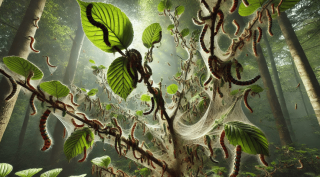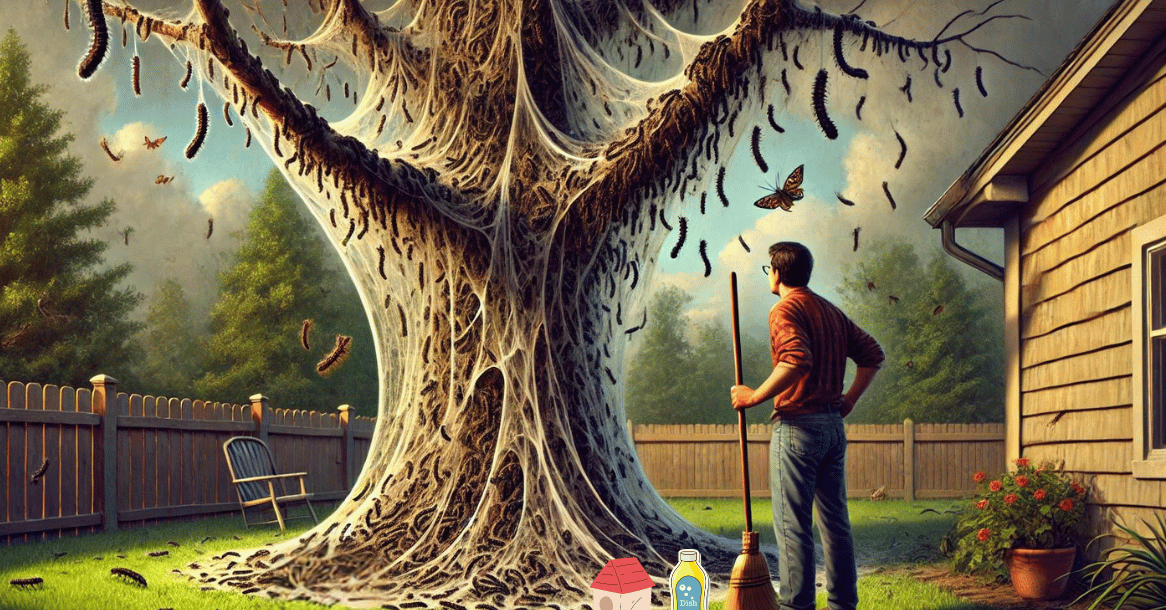Caterpillars can be a big problem for trees and plants. They chew through leaves, causing damage and weakening plants. If left unchecked, a caterpillar infestation can strip trees and gardens bare. Fortunately, there are natural ways to get rid of them.
Signs of Caterpillar Activity
Before treating an infestation, you need to confirm that caterpillars are the cause of the damage. Here are some signs to look for:
- Holes in Leaves – Caterpillars feed on leaves, leaving irregular holes.
- Skeletonized Foliage – Some species eat everything except leaf veins.
- Caterpillar Droppings (Frass) – Small black or green pellets on leaves or the ground.
- Silken Webs or Cocoons – Some caterpillars build protective silk nests on trees.
- Defoliation – Severe infestations can cause trees to lose most of their leaves.
If you notice these signs, it’s time to take action.
Types of Tree Caterpillars
Caterpillars come in many varieties, and some target specific trees. If you see leaf damage, webbing, or droppings, you might have a caterpillar infestation. Here are some common types to look out for:
- Oak Tree Caterpillars – These pests, including the oak processionary moth caterpillar, feed heavily on oak leaves. They can strip trees bare, weakening them over time. Some, like the spiny oak slug caterpillar, have irritating spines that can cause skin rashes if touched.
- Tent Caterpillars – These caterpillars spin large silk tents in tree branches, especially on cherry, maple, and oak trees. They emerge in spring and feed in large groups, leaving trees looking tattered. Removing their nests early can prevent severe damage.
- Gypsy Moth Caterpillars – Known for their destructive feeding habits, these caterpillars attack a variety of trees, including oak, birch, and aspen. They leave behind chewed leaves and large amounts of droppings. Severe infestations can kill trees over time.
- Fall Webworms – These caterpillars form webbed nests at the ends of tree branches, mainly on walnut, hickory, and pecan trees. Unlike tent caterpillars, they feed inside their webs, making removal tricky. Cutting off affected branches helps control their spread.
- Bagworms – Found on evergreen trees like junipers and cedars, bagworms build protective silk bags around themselves. They blend in with foliage, making infestations hard to spot until the damage is severe. Manual removal is the best way to stop them.
Caterpillars can be a serious problem for trees, but early identification and control can prevent long-term damage. If you suspect an infestation, acting quickly is key.
Identifying Caterpillar Species
Not all caterpillars are the same. Some turn into beautiful butterflies, while others can cause serious damage to trees and gardens. Identifying the species in your yard is the first step in choosing the right control method. Certain caterpillars feed only on specific host plants, so knowing what they eat can help you spot them early. Some species are nocturnal, meaning they do most of their damage at night. Others leave behind visible signs, like silk webs or tunnels.
If you’re unsure what type of caterpillar you have, there are many ways to identify them. Field guides and smartphone apps can help match their colors, markings, and behavior. Local resources, such as agricultural extension offices or local gardening clubs, can provide expert advice.
Entomologists—scientists who study insects—often share information on common species in your area.
Once identified, you can choose the best control method. For example, using natural insecticides like neem oil works well for certain species, while floating row covers or tunnel row covers can block pests from reaching plants. Planting repellent plants like marigolds or lavender can help keep them away naturally. By knowing what you’re dealing with, you can protect your garden without harming beneficial insects.
Habitat Modification
Making small changes to your garden can prevent caterpillar infestations before they start. One of the easiest ways to keep caterpillars away is to deter moths, as they lay the eggs that turn into hungry larvae. Reducing outdoor lights at night and planting repellent plants like lavender, marigolds, or dill can discourage moths from settling in your yard. Row covers are another effective way to protect plants. These lightweight fabric barriers block moths from laying eggs while still allowing sunlight and water to reach the plants.
If caterpillars have already moved in, relocating caterpillars can help reduce their numbers without harming beneficial insects. Moving them to a different area of your yard, away from food crops, can prevent further damage. For a more hands-off approach, encourage natural predators. Installing a birdhouse attracts birds that feed on caterpillars, helping to control the population.
Soil and moisture conditions also play a role in infestations. Avoid overwatering, as damp environments make plants more vulnerable to pests. Adding a layer of mulch can create a physical barrier, making it harder for caterpillars to reach the stems. If they tend to climb, cardboard or tin foil barriers wrapped around the base of plants can stop them in their tracks.
Rotating crops each season is another effective way to disrupt the caterpillar life cycle. Crop rotation prevents pests from returning to the same food source year after year, reducing infestations naturally. For infestations that persist, organic BT (Bacillus thuringiensis) is a safe bacterial treatment that kills caterpillars without harming plants or beneficial insects.
Caterpillars often leave behind silken threads, which can signal a bigger problem. If you notice stunted growth in plants, it’s time to act. By modifying the habitat with simple, natural methods, you can keep your trees and garden healthy while avoiding harmful chemicals.
How to Get Rid of Caterpillars
Caterpillars can damage trees and plants fast, but there are natural ways to stop them. If you see chewed leaves, silk nests, or caterpillar droppings, take action quickly.
- Remove by Hand – If you spot caterpillars, pick them off the leaves. Wear gloves and drop them into a bucket of soapy water. This works best for small infestations on garden plants and young trees. Also, check under leaves for eggs and scrape them off to prevent new caterpillars from hatching.
- Spray Neem Oil – Neem oil is a natural insecticide that stops caterpillars from growing. Mix it with water and spray it on affected plants, especially under the leaves. Neem oil won’t harm beneficial insects, and regular application helps keep infestations under control.
- Use Bacillus Thuringiensis (BT) – This bacteria is safe for people, pets, and plants but deadly to caterpillars. Spray it on your plants, and once the caterpillars eat it, they stop feeding and die within days. BT is an effective way to control caterpillars without using harsh chemicals.
- Remove the Nest – Tent caterpillars and webworms create silk nests in trees. These nests protect them from predators, so removing them is important. Use a stick or gloved hand to take the nest down and drop it in soapy water or burn it. This prevents caterpillars from spreading to other branches or trees.
Manual Removal Methods
One of the simplest ways to get rid of a caterpillar infestation is by removing them by hand. If you see caterpillars on your plants, wear gloves and pick them off. Drop them into a bucket of soapy water to prevent them from coming back. Check the undersides of leaves for caterpillar eggs and remove them before they hatch. Frass, or caterpillar droppings, is another sign to watch for. If you see it, there’s a good chance caterpillars are nearby.
For trees and shrubs, look for silk nests hidden in the branches. Removing the nest early stops more caterpillars from spreading. Use pruning shears to cut off affected areas, a method known as pruning and deadheading. This helps keep plants healthy and prevents further damage.
Homemade and DIY Solutions for Caterpillar Control
If you’re looking for non-chemical ways to get rid of caterpillars, homemade solutions can be just as effective. Many DIY control solutions use simple kitchen ingredients that are safe for plants, pets, and beneficial insects. A great option is a soap and water spray—just mix a few drops of dish soap with water in a spray bottle and apply it to leaves. The soap coats the caterpillars and disrupts their ability to feed.
Another eco-friendly solution is a vinegar spray. Mix one part vinegar with three parts water and spray it on affected plants. The acidity repels caterpillars without harming the environment. If you want a stronger deterrent, try a garlic and chili spray. Blend garlic, chili peppers, and water, let it sit overnight, then strain and apply. The strong scent keeps caterpillars away.
For long-term protection, encourage beneficial insects like ladybugs and lacewings, which naturally control pests. These DIY solutions are effective, non-toxic, and easy to make, helping you manage infestations without relying on chemical insecticides.
Causes of Caterpillar Infestations
Caterpillar infestations happen when conditions are just right for them to thrive. Understanding the causes can help you prevent them before they become a problem.
- Moths Laying Eggs – Moths are the main cause of caterpillar problems. They lay eggs on leaves, and when the eggs hatch, the larvae feed on plants. To stop this, reduce moth activity by using yellow sticky traps, keeping outdoor lights off at night, and spraying neem oil or Bacillus thuringiensis (BT) early in the season.
- Mixing Food Crops and Flowers – Vegetable gardens attract caterpillars because they provide plenty of food. If flowers and food crops are too close together, pests can spread more easily. Keeping them separate can help reduce infestations. Companion planting with herbs like dill and fennel also helps repel caterpillars.
- Lack of Companion Plants – Certain plants naturally deter caterpillars. Lavender, marigolds, basil, and fennel not only repel pests but also attract beneficial insects that prey on caterpillars. Without these plants, infestations can get worse.
- Replanting the Same Crops – Caterpillars often return to the same plants each year. If you grow the same vegetables in the same spot, you’re giving them an easy food source. Rotating crops disrupts their life cycle and makes it harder for them to establish large populations.
- Unprotected Plants – Without physical barriers, caterpillars can reach plants easily. Floating row covers shield young plants from hungry caterpillars, while sticky bands wrapped around tree trunks stop climbing caterpillars before they reach the leaves.
- Few Natural Predators – Birds are one of the best natural controls for caterpillars. If your yard lacks trees, shrubs, or birdhouses, you might not have enough birds to keep pests in check. Avoid using pesticides that harm birds, and consider adding features that attract them.
- No Caterpillar Deterrents – If you don’t take action, caterpillars will keep coming back. Diatomaceous earth is a natural powder that damages caterpillars’ bodies, making it hard for them to survive. Essential oil sprays with peppermint or citrus also work well. Applying these deterrents regularly helps keep caterpillars away.
By taking these steps, you can reduce caterpillar infestations and keep your plants healthy.
Contact Strobert Tree Services
If caterpillars are damaging your trees, we can help. Our certified arborists provide expert pruning, tree removal, and health care services. Contact Strobert Tree Services today for a free consultation.











